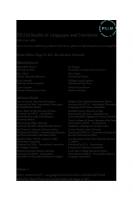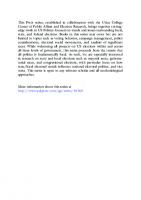Void and Voice: Questioning Narrative Conventions in Andr Gide's Major First-Person Narratives (North Carolina Studies in the Romance Languages and Literatures, 251) 0807892556, 9780807892558
Charles O'Keefe provides a close reading of Andre Gide's three major first-person narratives--L'Immoralis
134 36
English Pages 260 [262] Year 2018
Cover
VOID AND VOICE: QUESTIONING NARRATIVE CONVENTIONS IN ANDRÉ GIDE'S MAJOR FIRST-PERSON NARRATIVES
Title
Copyright
Dedication
TABLE OF CONTENTS
INTRODUCTION
CHAPTER ONE: L'Immoraliste
I. Narrative Form Touched by Excess
II. Questioning the Conventional Interpretation of the Framed Narrative in L’Immoraliste
A) Who Speaks?
B) Historical Context of Framed Narrative
C) New Critical Space
D) Paradigmatic Value of the Frame in L’Immoraliste
III. Contradictions Inherent in the Accessible Voice
A) Michel, An Echo of Ménalque
B) Michel, An Intertext of Rousseau
C) The Palimpsest
CHAPTER TWO: La Porte étroite
I. Jérôme as Editor
A) Jérôme the Misquoting "Author"
B) Narrator vs. Editor
i) Narrative Unreliability
ii) The "Main" Text
C) Critical Yield
i) Editing and Jérôme's Personality
ii) Editorial Unreliability
D) Forme et Fond
II. Onomastics
A) Names of Secondary Characters
B) "Alissa" and "Jérôme"
CHAPTER THREE: La Symphonie pastorale
I. How Do We Read a Lying Narrator?
A) The Critical Dawning
B) Accusing the Pastor
C) Justifying a Consideration of Narrative Lying
i) External Justifications
ii) Internal Justifications
D) Reading the Lie
E) Lying or Evangelizing?
F) The Hidden Agendas
G) Verbal and Erotic Anarchy
i) Narrative Disorder
ii) Limping Comparisons: Parabole>Parole>Parler
iii) The Erotic Parole
iv) The Destructive Parole
H) Semiosis and the Drama of Substitution
II. Onomastics
A) Onomastics in Gide's Text
i) Names and the Fatum of Writing
ii) Names and Subversion
B) Onomastics in the Pastor's Text
i) Naming and Point of View
ii) Naming as Assault
CONCLUSION
WORKS CITED
Back Cover
Recommend Papers

- Author / Uploaded
- Charles O'Keefe
File loading please wait...
Citation preview
UNIVERSITY OF NORTH CAROLINA AT CHAPEL HILL DEPARTMENT OF ROMANCE LANGUAGES
NORTH CAROLINA STUDIES IN THE ROMANCE LANGUAGES AND LITERATURES
Founder: URBAN TIGNER HOLMES
Editors: MARiA A. SALGADO
CAROL L. SHERMAN
Distributed by: UNIVERSITY OF NORTH CAROLINA PRESS CHAPEL Hll..L
North Carolina 27515-2288
U.S.A.
NORTH CAROLINA STUDIES IN THE ROMANCE LANGUAGES AND LITERATURES
Number 251
VOID AND VOICE: QUESTIONING NARRATIVE CONVENTIONS IN ANDRE GIDE'S MAJOR FIRST-PERSON NARRATIVES
VOID AND VOICE: QUESTIONING NARRATIVE CONVENTIONS IN
ANDRE GIDE 'S MAJOR FIRST-PERSON NARRATIVES
BY
CHARLES O'KEEFE
CHAPEL HILL NORTH CAROLINA STUDIES IN THE ROMANCE LANGUAGES AND LITERATURES U.N.C. DEPARTMENT OF ROMANCE LANGUAGES
1 9 9 6
Library of Congress Cataloging-in-Publication Data O'Keefe, Charles, 1942Void and voice: questioning narrative conventions in Andre Gide's major first-person narratives I by Charles O'Keefe. 257 p. - em. - (North Carolina Studies in the Romance Languages and Literatures: no. 251) Includes bibliographical references. ISBN 0-8078-9255-6 (alk. paper) 1. Gide, Andre, 1869-1951 - Criticism and interpretation. 2. Gide, Andre, 18691951. lmmoraliste. 3. Gide, Andre, 1869-1951. Porte etroite. 4. Gide, Andre, 18691951. Symphonie pastorale. 5. First person narrative. I. Title. IT. Series PQ2613.12Z65685 1996 848'.91209- dc20 95-21311 CIP
© 1996. Department of Romance Languages. The University of North Carolina at Chapd Hill. ISBN 0-8078-9255-6
DEP6SITO LEGAL: V. 1.202- 1996
I.S.B.N. 84-599-3447-0
ARTES GRAFICAS SOLER, S. A.- LA 0LIVERETA, 28-46018 VALENCIA- 1996
AMGD This book is dedicated to my teachers. While they really are too numerous for me to be able to name them all here, I must single out the ones who taught me the most: my family, those students at Denison University who insist on asking troublesome questions, and my Denison colleagues whose work in and out of the classroom I have tried to imitate in this book. I would like to offer a word of special thanks to Dr. Fran~ois Rigolot whose NEH seminar on narrative theory helped me articulate my main arguments, to the National Endowment for the Humanities for making that seminar possible, and to Denison University and its many, many generous supporters, whose funding for summer research, for leaves, and for a sabbatical encouraged me ever so concretely. Last but not least, I want to express my gratitude to the librarians at Denison University, and to those librarians around the country whom I have never met but who deal with interlibrary loans: if this book is found worthy of professional dialogue, other scholars will, I hope, reveal its strengths and weaknesses; but like me, they will not be able to do their work without the able help of librarians.
7
TABLE OF CONTENTS Page INTRODUCTION ... ...........•.................... .... ... ....•...... .•••......•. ............. ....
11
CHAPTER ONE: I:Immoraliste ...........................................................
28
I. Narrative Form Touched by Excess ...................................
28
II. Questioning the Conventional Interpretation of the Framed Narrative in I:Immoraliste ..................................................
29
A) B) C) D)
Who Speaks? .................. ..... .. ...... ..... ................. ... ..... .... Historical Context of Framed Narrative ...................... New Critical Space ........... ..................... .................... .... Paradigmatic Value of the Frame in I:Immoraliste ......
29 39 50 55
III. Contradictions Inherent in the Accessible Voice ... ............ A) Michel, An Echo of Menalque ...................................... B) Michel, An Intertext of Rousseau .... ............................. C) The Palimpsest ............ ..... ............... ............. ...... ...........
67 67 70 80
CHAPTER Two: La Porte etroite ................................. ·······················
96
I. Jerome as Editor .................................................................. A) Jerome the Misquoting" Author" ................................. B) Narrator vs. Editor ........................................................ i) Narrative Unreliability ............................................. ii) The "Main" Text...................................................... C) Critical Yield .... .............. .............. ..... ............... ........ ...... i) Editing and Jerome's Personality ............................ ii) Editorial Unreliability .............................................. D) Forme et Fond ...............................................................
96
96 102 103 112 124 126 139 144
II. Onomastics ................ ....... ...... ..... ....... ................... ....... ... .... A) Names of Secondary Characters ................................... B) "Alissa" and "Jerome" ..................................................
152 153 157
9
10
ANDRE GIDE'S MAJOR FIRST-PERSON NARRATIVES
Page
THREE: La Symphonie pastorale ........................................
162
I. How Do We Read a Lying Narrator? ................................. A) The Critical Dawning ............................ ................. ....... B) Accusing the Pastor ....................................................... C) Justifying a Consideration of Narrative Lying .... ..... ... .. i) ExternalJustifications ............................................. ii) InternalJustifications .............................................. D) Reading the Lie ............................................................. E) Lying or Evangelizing? .................................................. F) The Hidden Agendas .. ........ .................. .. ...... ......... ....... G) Verbal and Erotic Anarchy........................................... i) Narrative Disorder .................................................. ii) Limping Comparisons: Parabole>Parole>Parler ... iii) The Erotic Parole ........................... ...................... .. iv) The Destructive Parole............................................ H) Semiosis and the Drama of Substitution ........ ....... ..... ..
162 163 168 173 173 176 181 185 190 194 195 199 204 208 209
II. Onomastics .......................................................................... A) Onomastics in Gide's Text ........................................... i) Names and the Fatum of Writing ........................... ii) Names and Subversion .. ......................................... B) Onomastics in the Pastor's Text .................................... i) Naming and Point of View ..................................... ii) Naming as Assault ..................................................
211 211 211
CoNCLUSION ........... ................. ...................... ....................................
226
WORKS CITED .....................................................................................
250
CHAPTER
213
216 216 220
INTRODUCTION "Jusqu'a present je n'ai vu clairement qu'une chose: c'est que je n'etais ni ceci ni cela. Et pourtant je suis, malgre que le monde m'affirme que je ne puis etre que l'un ou !'autre. Et je suis en depit de l'un et de I' autre, et de tout . . . et du moi-meme qui, hier encore, souriait. Voila pourquoi mon lot est, d' abord, d' etre suspect a tous." Andre Gide, Co"espondance, lettre de Gide aF-P. Ali-bert, 17 jan. 1914.
Among literary critics, Andre Gide has long enjoyed considerable and justified renown- the term "notoriety" would not be inappropriate- for unsettling but cogent works that challenge both traditional morality and traditional forms: Les Nourritures terrestres (1897), a rapturously lyric narrative of the problems of liberation no less sensual than textual; Les Caves du Vatican (1914), a rollicking sotie that, using for instance Lafcadio's homicidal acte gratuit, comically assaulted traditional novelistic techniques and values, to the applause of restless and rebellious intellectuals reacting to warspawning "rationality" at the beginning of the century; and Les Faux-Monnayeurs (1925), Gide's most complex subversion of the traditional novel and of traditional mores that, among other provocations, pushes the conceit of the mise en abyme to the point where the book becomes a "diary within a novel within a diary within a novel within a diary" (Guerard 164). Even Gide's heretofore less read and much dismissed oeuvres de jeunesse have been recognized of late for their revolutionary qualities. Consider for instance Paludes (published in 1895), which "swamps" the reader in a self-reflective send-up of a book about a book representing the tedious Symbolist vie de salon. Emily Apter has written: 11
12
ANDRE GIDE'S MAJOR FIRST-PERSON NARRATIVES
[Paludes'] exposure of fictive illusions; its ambiguous first-person pronoun (confusing narrator, author, character and reader); its multiple framing of events and non-events; its mechanical repetitions of phrases and narrative fragments; its dialogue punctuated by non-sequiturs and its typographical and stylistic likeness to a sketch or tentative plan of a narrative (close to what Marguerite Duras, in reference to her own work, dubbed "blueprints of novels"), all these features, as many critics have noted, announce "l'ere du soup~on" -the era in which the presumed innocence of fiction is severely and irrevocably called into question. Similar in its narrative experimentation to the works of Robbe-Grillet, Sarraute, Butor, Simon and Duras among others, Paludes offers an early paradigm of the twentieth-century "oeuvre-critique," or genre of theoretical fiction. (Apter 72)
And yet his most famous first-person narratives, J;Jmmoraliste (1902), La Porte etroite, (1909) and La Symphonie pastorale (1919), have had an entirely different critical history. On the one hand, these works - eventually called recits by Gide 1 - have subject matter truly no less provocative than that of anything he wrote: (respectively) repressed pederasty, suicidal religiosity, and clerical hypocrisy, with lethal misogyny at work in each. To heighten the provocation, each of the main characters views his/her deadly conduct as ennobling moral exploration: Michel sees himself embarked on a renegade hunt for his "authentic being," Alissa feels that she is striving for spiritual perfection via la porte etroite advocated in the Gospels, and the Pastor claims to be rejecting hidebound Pauline limits on Christ's teaching on love. Understandably, a great deal has been written about what happens in these truly striking stories. On the other hand, not nearly as much has been done to determine if the aesthetically scrupulous Gide used his great sense of literary form to create in these three recits basic narrative structures provocative enough to suit the subject matter. This lacuna exists even though the recits were written during roughly the same time span as the more "notorious" works that have gotten a more balanced critical reception. Not that in any number of critical studies ample insightful scrutiny has been spared on certain aspects of their form, for in' See Maisani-Leonard, 21-30, for Gide's use of the term and for an attempt to identify the characteristics of a Gidean recit.
INTRODUCTION
13
stance, on the gradual change in rhythm and tone of Michel's words, on the impact of }~rome's progressively incorporating Alissa's direct words into his own narrative, and on the consequences of the Pastor's time of narration slowly coinciding with the time of the story. Moreover and quite naturally, given recent critical tendencies, increasing attention has been brought to bear on narrational reflexivity in Gide's recits, on the fact that, as David H. Walker has succinctly put it: "The 'story' is used as a pretext for examining 'storytelling"' (Walker, 'Les Nourritures terrestres' et 'la Symphonie pastorale,' 189. See also Helbo, Sonnenfeld ["On Readers and Reading"], Ireland ["Le Jeu des 'je' "], Babcock [Portraits of Artists], Kapetanovi









